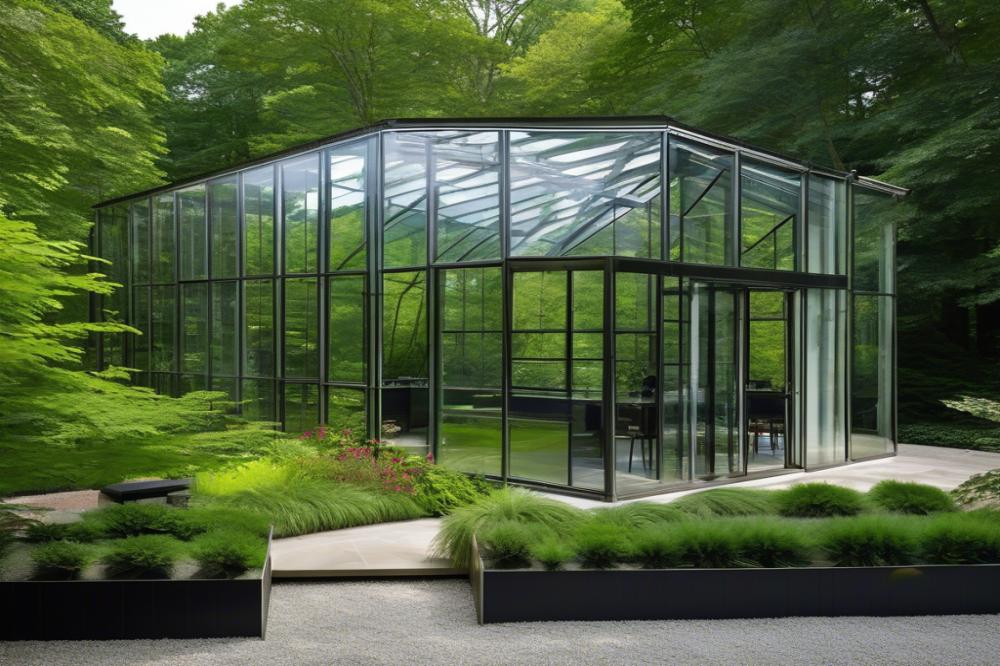Introduction
famous sheds have gained attention in the world of modern architecture. These structures often challenge traditional building ideas while showcasing unique design principles. Among these, the Glass Shed stands out as a significant example. This structure represents a pivotal moment in the minimalist design movement, characterized by simplicity and functionality.
Philip Johnson was a leading figure in this movement. His work often pushed the boundaries of what architecture could be. The Glass Shed reflects his innovative approach and pure vision. Located in New Canaan, Connecticut, this landmark serves as more than just a structure; it embodies a philosophy of design that values light, space, and nature.
The Glass Shed, often described as an artist retreat, provides a perfect setting for creativity. It merges indoor and outdoor spaces, allowing the beauty of the surrounding landscape to become part of the living experience. This architecture is a notable piece in the history of modernism, influencing countless architects and designers since its completion. The structure invites observers to appreciate both the simplicity and elegance of its form.
The Design and Features of the Glass Shed

The Glass Shed stands as an iconic piece of architecture in Connecticut. Its design showcases the principles of modernism that have influenced numerous structures. This structure is often viewed as a landmark in New Canaan, a town revered for its architectural significance.
Architectural Style
Minimalist design defines the Glass Shed, where simplicity reigns. Windows stretch from floor to ceiling, offering an unobstructed view of the surroundings. Clean lines characterize the exterior, creating a harmonious balance between the building and nature. This style reflects a broader movement in architecture that emphasizes both form and function.
Materials and the Use of Glass
Glass predominates the construction of the structure, making it a quintessential example of glass houses. Aside from its aesthetic appeal, the use of glass allows light to flood the interior. This choice of material not only enhances the visual connection between inside and outside but also embodies the principles of transparency celebrated in modernist architecture. Wood and steel complement the glass, adding warmth and stability.
Integration with Surrounding Landscape
The relationship with nature is remarkable. Situated amid lush greenery, the Glass Shed blends seamlessly into its environment. Views of the landscape can be appreciated from every angle. The design approach respects and highlights the natural beauty around it, creating an artist retreat that inspires creativity.
Concept of Transparency in Modernism
Transparency plays a crucial role in the essence of modernist architecture. This principle reflects a desire for openness, both visually and philosophically. The Glass Shed encourages dialogues between the inside and outside worlds, promoting a sense of freedom. Such architectural elements echo the thoughts of many modernist artists who sought to redefine boundaries.
Philip Johnson‘s Vision and Influence

Philip Johnson played a crucial role in shaping American architecture. He was a pioneer of modernism, a movement that transformed buildings into works of art. His influence can still be felt today, as many architects draw inspiration from his ideas. Johnson’s focus was on creating spaces that harmonized with their surroundings. He believed that design should be both functional and beautiful, a principle evident in many of his projects.
The Glass Shed in Connecticut is a perfect example of his architectural philosophy. This structure embodies a minimalist design approach, showcasing simplicity and elegance. Large glass walls invite natural light, making the indoor space feel connected to the outside landscape. By using glass, he challenged traditional ideas about building materials and opened up new possibilities in architecture.
In the context of Johnson’s other works, the Glass Shed stands out as a personal landmark. He created it as a sanctuary for creativity and reflection. This structure is distinct from his more famous glass houses but retains the same artistic spirit. It demonstrates his ability to adapt his design principles to different contexts and purposes.
Artists often seek inspiration in quiet, beautiful spaces. The Glass Shed serves as an artist retreat, offering a peaceful environment to create. Its open design encourages creativity and thoughtful exploration. Many have found themselves drawn to its unique atmosphere, allowing for moments of tranquility. For those who appreciate architecture history, this building is more than just a place; it is a testament to the vision of a great architect.
A visit to the Glass Shed reveals Johnson’s genius in blending nature and structure. The surrounding New Canaan area enhances its charm and influence, making it an ideal setting for artistic pursuits. It is a space that invites contemplation, reflecting its creator’s innovative spirit. The Glass Shed is a remarkable piece of modernism, and it continues to inspire those who value thoughtful design.
Cultural and Historical Context

The Glass Shed, an iconic creation nestled in Connecticut, offers much more than just a visual spectacle. This structure fits neatly within a broader narrative of architecture history. It symbolizes the modernist movement, showcasing how artistic intentions meld with functional design. In essence, the Glass Shed serves as a convergence point for various architectural ideas and movements.
New Canaan is a significant hub for modernist architecture. The area became a playground for innovative architects keen on exploring new design philosophies. This welcoming environment fostered creativity. With its charming homes and striking landscapes, New Canaan attracted both artists and architects seeking inspiration. The Glass Shed stands as a testament to this vibrant community.
Comparing the Glass Shed with other famous glass houses reveals interesting trends in design. Structures like the Farnsworth House and the Villa Savoye also utilize clear materials to dissolve boundaries between inside and outside. Each of these designs contributes to a heightened appreciation of nature and light. However, Johnson’s work at the Glass Shed carries a distinctive character that makes it a landmark in its own right.
The influence of the Glass Shed extends beyond its immediate context. It has left a mark on subsequent architectural movements that embrace minimalist design. Architects who favor simplicity often look to this building for inspiration. The way natural light floods through its walls invites a conversation about the relationship between environment and dwelling. Considering the growing popularity of sustainable design, the Glass Shed’s legacy is likely to influence many future projects.
The Legacy of the Glass Shed
Current Status and Preservation Efforts of the Glass Shed
The Glass Shed stands proudly in New Canaan, Connecticut. Preservation efforts are critical to maintaining its unique charm. Various organizations have rallied to protect this landmark. Local architectural groups often highlight its importance in modernism. Restoration work focuses on the original materials and design of the structure. Ongoing maintenance ensures that the building remains a symbol of minimalist design. Many see it as more than just a house; it is an artist retreat.
Views in Architectural and Design Contexts
Today, the Glass Shed is viewed as an iconic piece of architecture. It is frequently studied in architecture history courses. Many design enthusiasts visit to admire its clear glass walls. The way it merges with nature captivates architects and art lovers alike. Critics often praise its simplicity and elegance. Glass houses like this one have influenced countless modern buildings. Layers of light and transparency define its space, making it a subject of admiration.
Continuing Relevance in Modern Architecture
Johnson’s work remains influential in the field of design. Many contemporary architects draw inspiration from his approach to space and light. His ideas about integrating nature with structure are still relevant today. The Glass Shed exemplifies how architecture can reflect simplicity while offering comfort. In a world where design can often feel complicated, this structure reminds us of the beauty in minimalism. It continues to inspire discussions about the role of glass in architecture. The blend of indoor and outdoor spaces shapes modern architectural practices even now.
The Lasting Legacy of the Glass Shed
The Glass Shed in Connecticut stands as a notable emblem in architecture. Its sleek, transparent design reflects the principles of minimalism and the integration of nature with built environments. This structure showcases how simplicity can generate profound aesthetic and functional values. Minimalism encourages a dialogue with surroundings, and the Glass Shed exemplifies that connection remarkably.
Impact on modern design is undeniable. Ideas introduced by this iconic shed resonate in countless projects around the globe. It challenges traditional notions about what a workspace should be, leading to creative freedom in design. Johnson’s work invites us to reconsider how we interact with space, making his influence last well beyond his lifetime.
Exploring the world of famous sheds and minimalist designs can be an inspiring journey. Each structure tells a story. They reveal how thoughtful design contributes to our understanding of space and function. From backyard studios to large public facilities, these creations encourage individuals to think outside the box. Embrace the simplicity and elegance found in various forms of architecture.



